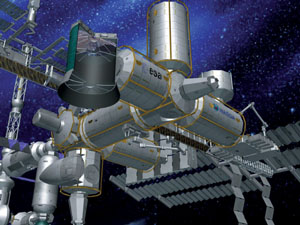Joining the Pierre Auger Observatory in the long term will be ESA’s Extreme Universe Space Observatory (EUSO), which is scheduled to fly on the International Space Station from 2008. Comprising a wide-angle telescope that is sensitive to the ultraviolet region, the EUSO array will look down on Earth, some 400 km below, to pick up the fluorescence that is generated by cosmic rays above the Greisen, Zatsepin, Kuzmin (GKZ) cut-off.
EUSO will take in much larger areas than the Auger Observatory, with its 60° field of view sweeping over 150,000 sq. km of the Earth’s atmosphere at every pass. As cosmic-ray showers develop in the atmosphere, light is also generated through the Cherenkov effect, with photons being emitted in a narrow cone that follows the particle trajectories. On reaching the surface this light is reflected, resulting in a terminal flash in the EUSO telescope that will be used to reconstruct the cosmic-ray track.

Conceptually simple, the telescope’s 2.5 m diameter optics consist of Fresnel lenses that focus light onto a plane surface made up of multinode photomultipliers with 250,000 pixels. Each pixel covers approximately 1 sq. km of the Earth’s surface. This resolution is sufficient because at such high energies a cosmic shower can cover dozens of square kilometres when it reaches the Earth.
The total number of excited pixels is governed by the random background noise from residual light on a moonless night. The experiment therefore only takes data when the telescope passes through the Earth’s shadow; for the EUSO telescope, night lasts only 45 min and is repeated 16 times every 24 h. In the three years scheduled for the EUSO mission, some 3000 events above the GKZ cut-off are expected.





